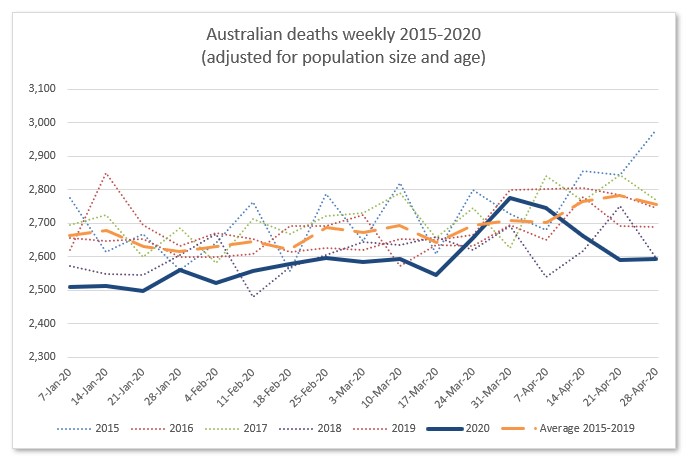The ABS has released Australian population mortality statistics up to 28 April. While there were a few more extra Covid19 deaths than counted in late March and early April, since then death rates in the population as a whole are largely lower than in previous years.
The graph below shows the whole picture.

A month ago, I blogged about the Australian Bureau of Statistics’ first release of mortality statistics this year – did it suggest there were more Covid19 deaths than being counted? I was a cautious yes. And now, with an extra four weeks of data, there are likely to be a few more in early April, but since then there don’t seem to be any more.
The ABS has released the provisional number of deaths each week for the first 17 weeks of 2020, together with the equivalent weeks for each of the years 2015-2019. I took those, and adjusted them for population size (there are nearly 2 million more people, which is 8% more, in Australia now than there were in 2015) and for the age structure of the population (the population is getting gradually older each year, which means you would expect death rates to go up). After doing that adjustment, you can see that there are only two weeks so far in the published data where total deaths were higher than the adjusted average from the previous five years.
Those two weeks were, not coincidentally, the two weeks with the most COVID19 deaths in the timeframe – the week ending 31 March 2020 had 68 more total deaths than the adjusted average, and 11 reported Covid 19 deaths, and the week ending 7 April had 44 more deaths than the adjusted average, and 29 reported Covid 19 deaths. Looking at those two weeks alone, it is probably reasonable to suggest that there may have been up to 40 – 60 extra deaths from COVID19 than those reported. After that, while there were more Covid19 deaths (another 40 over the rest of April), the excess deaths went back down, suggesting that there were few or no Covid19 deaths occurring without being identified.
You can see from the graph above that for every other week, reported deaths in 2020 were lower than the adjusted average, suggesting that it was only in those early stages in Australia that deaths were occurring from Covid19 without being identified. But there probably were some.
And how might those deaths have been recorded? There are two causes of death that look suspicious in the ABS statistics. First pneumonia and Influenza (which is mostly pneumonia, influenza deaths have been very low this year). As you can see below there are deaths above the normal range (noting that the normal range has not been adjusted for population size and age) particularly around the end of March and beginning of April.

And the graph below shows that Diabetes deaths have been higher than normal since around the middle of March (again not adjusted for population size or age). Diabetes is known to be an underlying condition that worsens the outcomes for Covid19.

Links
With Victorians now being required to wear facemasks when out side the house, and increasing discussion of whether people in NSW should be doing the same, I’ve got some links about the science. First, this systematic review and meta-analysis by Derek Chu and colleagues in The Lancet clearly suggests wearing masks should be an important part of the community health armoury against Covid19.
This study supports universal face mask use, because masks were equally effective in both health-care and community settings when adjusted for type of mask use. Growing evidence for presymptomatic and asymptomatic transmission of SARS-CoV-213 further supports universal face mask use and distancing. In regions with a high incidence of COVID-19, universal face mask use combined with physical distancing could reduce the rate of infection (flatten the curve), even with modestly effective masks.Universal face mask use might enable safe lifting of restrictions in communities seeking to resume normal activities and could protect people in crowded public settings and within households.
This study of an Antarctic cruise which was completely isolated from outside human contact for 28 days, has a couple of interesting insights. First, there was a very high proportion – 81%, which is the highest I’ve seen yet – of ultimately Covid19 positive cases which were asymptomatic.
Despite 128 (59%) of the population testing positive, fever and mild symptoms were present in only 16 of 128 COVID-19-positive patients (12.5%), with another 8 medically evacuated (6.2%) and 4 requiring intubation and ventilation (3.1%). There has unfortunately been one death to date (0.8%). There were therefore a total of 24 COVID-19-positive patients who were symptomatic (19%), with the majority being asymptomatic (104 patients or 81%).
But secondly, I was alerted to this study by someone who wondered whether the high proportion of people who weren’t sick or only mildly sick might be because most people who caught Covid19 were not highly exposed, given how carefully isolation protocols were implemented:
Isolation protocols were immediately commenced, with all passengers confined to cabins and surgical masks issued to all. Full personal protective equipment was used for any contact with any febrile patients, and N95 masks were worn for any contact with passengers in their cabins. The crew still performed duties, including meal services to the cabin doors three times a day, but rooms were not serviced. Expedition staff helped with crew duties at meal service.
Perhaps wearing masks could also reduce the severity of the disease in those who catch it? That’s a highly speculative conclusion to draw, but an interesting one.
And finally, for my NSW readers, a reminder of geekinsydney’s COVID near me page. It now shows you the home postcode of all positive cases in NSW in the last 7 or 14 days, which cases are from hotel quarantine, and which are local.
Life Glimpses
Given my comments above that we should be wearing masks in NSW, we’ve been debating whether we should wear them before it becomes compulsory. The issue is that mask use is only really effective when everybody does it. Our own individual risk is lowered very slightly if we wear masks while shopping or on public transport, but population spread drops materially if enough people start wearing them. So we’ve compromised, and we’ve started grocery shopping on line and mostly stopped catching public transport.
But we now have some good cloth masks in the house, so we’ll probably be wearing them if we need to go indoors in a public place.
Bit of Beauty
This beautiful flower was captured by geekinsydney on the South Coast a few weeks ago, and has excellent symmetry.

Do thank the geekinsydney for his contribution. Love to you both
a mask wearer in public
Thanks, Jennifer,
I checked the latest NSW Health report on pneumonia and influenza and, as expected, the numbers are well down on “normal”. This week’s report quotes 12 deaths from influenza in 2020 compared with 79 for the same period last year. I fully expect that the gap will widen dramatically in the next month or so. I hope that the Covid deaths don’t fill much of that gap.